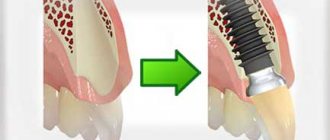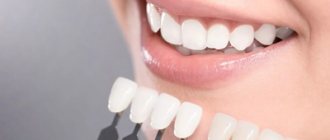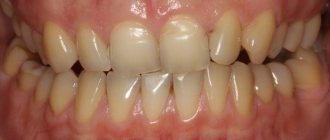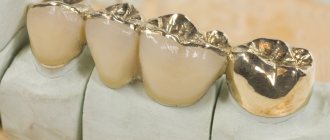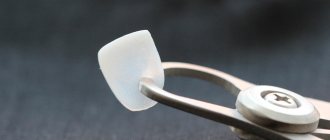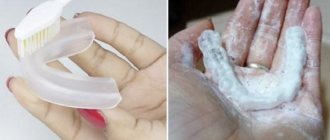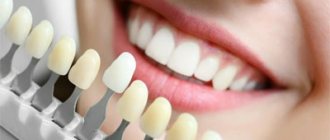Modern achievements in dentistry will help those who are not naturally gifted with strong teeth to smile widely and without embarrassment. In dentistry, several therapeutic, preventive and surgical methods have been found that can restore teeth to their former aesthetic appeal. One of the most effective methods is rightly considered to be the installation of veneers. Veneer colors may vary depending on the material and aesthetic need.
Veneers are not only a dental shield from the destructive effects of harmful microorganisms and substances, as well as from the influence of the external environment. This is, first of all, “clothing” for each tooth, allowing it to look healthy, even and attractively white. Veneers smooth out small defects in the dentition; they also mask chips, cracks and dark spots on the enamel.
Patients often ask the question, “What about the color of the veneers? Won’t they look defiantly unnatural?” The question is justified and requires a detailed answer, because beauty first of all includes naturalness.
Natural color of veneers
The attractiveness of a smile is characterized by three main parameters: the color of each tooth, its position in the dental “structure” and shape (state of integrity). This is understandable: a clean and white tooth, correctly positioned in the dentition, without chips, stones or cracks, looks much more attractive than a crooked tooth yellowed from plaque.
If there are no obvious defects in the dentition, then when you smile, the first thing that catches your eye is the color of your teeth. Regardless of subjective opinion, assessing the importance of the interlocutor based on the condition of the teeth occurs at the level of a reflex. The condition of the teeth determines the physiological “reliability” of a person, his health, endurance and strength. Therefore, according to natural and human canons, a wide, snow-white smile is attractive and conducive to trust. And, on the contrary, a person with ugly teeth and bad breath evokes antipathy in us.
It would seem that by installing snow-white veneers, a person makes his smile beautiful and attractive. From one point of view, yes, it’s beautiful and even, but on the other... Deliberate snow-whiteness creates a feeling of unreality, falseness. Maybe this is where patients' concerns are expressed that their teeth may look unnatural? Each person has his own “own” color of healthy teeth. The unnaturalness of even an immaculately white smile is striking and may even have the opposite of the desired effect - not at all attractive.
In this regard, dentists have developed a special veneer color scale, which makes it easier to select colors that are closest to the patient’s dentition. The advantage of the reference scale is not only in facilitating the dentist’s work when selecting colors for veneers, but also in the fact that standardization of color selection leads to a clear algorithmization of the process, due to which the likelihood of unsuccessful color selection is sharply reduced.
Vita veneer color scale
The scale was developed based on the principles of artistic colorimetry. Shades are divided into four categories, designated by the symbols A, B, C and D.
The principle of distribution of shades: if you add a drop of red, green, yellow or gray paint to a palette of pure white, you will get the corresponding categories:
- A-category. Reddish-brown shades.
- B-category. Reddish-yellowish shades.
- C-category. Gray shades.
- D-category. Reddish-gray shades.
In each category there is an additional distribution of shades, which is characterized by the degree of brightness. The number “1” corresponds to the highest level of brightness on the scale, and “4” corresponds to the lowest.
Thus, the selection of veneers based on tooth color is carried out according to two parameters: shade (A, B, C or D) and brightness value (1, 2, 3, 4), and the color for each veneer based on tooth color is determined by a double symbol, for example, veneers color A1.
This is the advantage of standardization: no matter what dental office you contact, if you know the result of the selection that seemed most successful, then you just need to name these designation symbols. So the veneer of color B1 will be exactly the same in shade and brightness everywhere as it was during the initial color selection.
Rules and conditions for determining tooth color
The color of the tooth is determined at three points: in the middle part of the tooth, in the cervical and incisal-occlusal parts. This is necessary to create a natural color effect, since the surface of the tooth enamel in different areas of the tooth has a different shade. The condition of the gums, the tooth itself, and the thickness of the tooth enamel are involved in the manifestation of the difference in shades on the surface of the tooth.
To optimally select veneers based on tooth color, the following conditions must be met:
- The color of teeth is determined only in daylight. Any artificial lighting has a predominant shade in its spectrum, which is associated with the nature of the specific material that emits this light. In this case, the illumination intensity should not exceed 1500 lux. Neglecting the last requirement may cause an error in determining the desired brightness of the hue. Some dental offices use installations that simulate light from the solar spectrum. The advantage of such installations is that they are adjustable in light intensity, which allows you to create conditions close to ideal for determining the shade and its brightness.
- White color is more reflective than absorbing, therefore, to determine the most suitable shade, you need to take into account that the office in which the color selection is carried out does not include an interior of “screaming” tones, the walls are painted in even light colors. Clothing, its accessories, and dentist’s gloves can also distort perception when choosing a shade. If you need to achieve quality when choosing a color, you need to take into account any little thing that can distort the natural shade.
- Moisture levels also play an important role in determining the color of teeth. Dry enamel has a completely different reflective ability than moistened one. In addition, you need to take into account details such as the patient's makeup and lipstick. Of course, any “extra” paint on the patient’s face can greatly distort the correct perception of color.
- Some dentists also believe that the natural perception of tooth color is influenced not only by external factors, but also by the emotional state of the patient, so you need to worry in advance about a comfortable, friendly environment when communicating between the dentist and the patient.
After the conditions for optimal determination of the color of the teeth have been met, the dentist performs a simple color selection procedure: the first stage, by comparison with the applied scale standards, is the shade selected, and then, when the shade is selected, the brightness is determined.
Useful tips
To make the result of prosthetics with veneers look harmonious, experts give each other some advice that works effectively when choosing the shade of a cosmetic product:
- Take into account the patient’s eye color and white tint.
- Pay attention to the proportion of melanin in the patient’s skin and hair color - in dark-skinned people, teeth and whites look whiter. For patients with Slavic appearance, it is better to have veneers in natural colors.
Dentists also have a number of recommendations for patients:
- Before visiting a dental clinic to select the color of future cosmetic overlays, it is prohibited to apply decorative cosmetics to your face.
- It is not advisable to wear flashy, flashy clothes and accessories before going to the dentist. It is better to choose something in light, calm colors in your wardrobe.
- You cannot whiten tooth enamel the day before the procedure for selecting the optimal color.
Remember! The composite material used in the manufacture of esthetic products for dental restorations looks different after prosthetics than ceramics, even with the same shade index. Therefore, it is important to take this fact into account before veneering.
In the video, the patient explains the principle by which she chose the color of the veneers.
Attractiveness and self-expression
There is a category of patients who turn to dentists not so much to restore their teeth, correct their bite or hide imperfections. This category of patients wants to enhance their attractiveness by changing the color of their teeth or applying various decorations to their teeth.
In these cases, the color of the veneers is selected according to the patient’s wishes. If the patient, for example, is not embarrassed by the white color of the veneers, without the shades that are typical of natural tones, then the dentist can help show how such teeth will look from the outside.
Gold, which has long been used in dentistry, does not lose its prestige and extravagance. Metal veneers are becoming a new fashion trend - “grillz” are installed by famous pop stars, actors and top models.
Gold (platinum) veneers are not just a necessity, many young people consider them the same way of self-expression as tattoos or piercings.
Veneers decorated with applications of precious metal petals or inlaid with precious stones are gaining popularity. The advantage of such dental decoration is that no additional grinding or drilling is required, which in the future, undoubtedly, only benefits the preservation of teeth.
Choice
Each patient can decide what aesthetic value the veneers will bear; based on this, the color and material of the veneers are selected.
- Material. Composite veneers are not as expensive as porcelain veneers, but porcelain veneers have the important advantage of not changing color over time. Metal veneers (particularly gold ones) have many positive aspects. The only significant drawback is that the metallic color is far from the natural color of the teeth.
- Color. Most patients strive for natural shades of white. Frequently changing dental veneers is not advisable, so if the patient decides on an extravagant shade of veneers, then such an action requires prior clarification that each change of veneers will be accompanied by an impact on the tooth enamel, which has a negative effect on the teeth.
- Decorations. Jewelry that is attached to the veneers themselves does not have any effect on the teeth, since they do not come into contact with tooth enamel. Such decorations in the form of appliqués and attached stones can be easily removed from veneers; accordingly, one decoration can be replaced with another with the same ease.
Reviews
Every patient who wants to use the service of aesthetic dental restoration (veneering) must understand that the products used in prosthetics, with good care, have a long service life and will please their owner for quite a long time.
Therefore, choosing the appropriate shade is an important and responsible procedure, during which the doctor must evaluate the natural integration of the selected color into the smile area.
If, after reading the article, you have a desire to share with readers your personal opinion about the optimal shade of veneers and talk about your personal experience of installing them, leave your review in the comments below.
Perhaps your recommendation will help many avoid problems and mistakes before a dental procedure to improve the appearance of a smile.
If you find an error, please select a piece of text and press Ctrl+Enter.
Tags veneers fixed dentures
Did you like the article? stay tuned
Previous article
Are canine braces the only way to correct a “vampire smile”?
Next article
VSD aligners – an individual solution for the correction of malocclusions
Care
Despite the fact that the material for making veneers was selected taking into account the effects of the alkaline environment of the oral cavity, sudden changes in temperature (hot drinks, ice cream, environmental influences, chewing loads), it is advisable not to forget that even real tooth enamel cannot withstand such loads and begins to collapse.
In this regard, you need to remember to care for veneers in order to extend their shelf life and preserve the original color. Moreover, veneers do not require special care; daily teeth brushing and infrequent visits (1-2 times a year) to the dentist are sufficient.
Additional conditions of care include some restrictions:
- Avoid drinking very hot drinks and ice cream
- Do not bite nuts or peel seeds.
- Limit your consumption of strong tea, coffee, as well as other drinks and products that contain persistent pigment, since traces of pigmentation tend to accumulate over time.
Sources used:
- Abolmasov N. G., Abolmasov N. N., Bychkov V. A., A. Al-Hakim “Orthopedic dentistry”, M., 2003
- THE BRITISH SOCIETY FOR RESTORATIVE DENTISTRY. "CROWNS, FIXED BRIDGES AND DENTAL IMPLANTS GUIDELINES"
- Notes of a good dentist / E.G. Aghajanyan. - M.: Omega, 2011.
How to maintain results for a long time
After dentures or whitening, it is very important to keep the color of your smile natural. To do this, it is important to follow the recommendations for caring for dentures (if artificial crowns or veneers were installed) or directly for the teeth (after the whitening procedure).
As a rule, the main stages of care are daily oral hygiene, exclusion from food (at least for the first weeks) of coloring foods - berries, wine, strong tea or coffee, as well as quitting smoking.
Good to know! Bleached enamel becomes thinner, and therefore more sensitive, so to care for it you need special gentle pastes and brushes with soft bristles. Doctors also advise rinsing your mouth after every meal and using floss for high-quality cleansing.
The same goes for veneers and ceramic inlays. For example, it is not recommended to use electric ultrasonic toothbrushes if you have such microprostheses, since the high frequency of rotation or vibration of the brush head can heat the prosthesis or peel off the adhesive, which leads to deformation of the prosthesis or a reduction in service life.
Do not forget to visit the dentist once every six months so that he can monitor the condition of the oral cavity and dentures, adjust hygiene procedures, and also diagnose the presence of diseases, in particular caries, in a timely manner.
